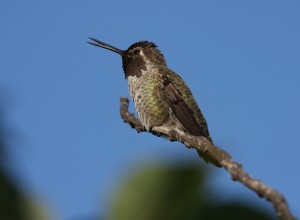Humming Their Own Tune
In the bird world, there’s usually a pretty big difference between vocalizations that are learned and those that are not learned. By and large, learning birds can produce much fancier songs than their learning-impaired cousins – perhaps because coding music directly into the DNA takes up a lot of genetic “disk space,” introducing limits on the complexity of genetically-determined vocalizations.

If you flip through a North American field guide, you might notice that the birds in the front half of the book (ducks, hawks, owls, gulls, woodpeckers) tend to have pretty simple vocalizations, whereas all the most acclaimed avian singers (wrens, thrushes, finches, mockingbirds and thrashers) are in the second half of the book. This is no coincidence. First, birds in the order Passeriformes (the huge order that encompasses the second half of the field guide) sport a uniquely complex set of muscles to control their syrinx, enabling them to perform much more spectacular feats of vocal gymnastics. Second, with the important exception of the flycatchers, most North American passerines learn their songs.
However, the learning of complex songs isn’t restricted to the so-called “songbirds.” In fact, some of the best examples of learned, complex songs come from a family that isn’t in the Passeriformes at all: the hummingbirds.
To people in most parts of North America, this may come as quite a surprise. That’s because our most widespread and familiar hummingbirds — Ruby-throated, Black-chinned, Broad-tailed, and Rufous — actually don’t sing songs at all; their vocalizations are limited to a variety of chip notes and buzzes, and produce their territorial sounds mechanically, with trilling wings or chirping tails in display dives. But to those who live along the West Coast or in the southwestern deserts, the soft but astonishing song of the Anna’s Hummingbird is a familiar sound:
And Anna’s is no fluke. Behold the vocal stylings of a Green-throated Mountain-Gem, a Central American relative of the Blue-throated Hummingbird:
Laboratory experiments have demonstrated that at least Anna’s Hummingbirds learn their songs, and as one would expect, the songs vary regionally as a result. Although not all hummingbird songs are as complex as the examples above, the variation in songs can be tremendous. Check out Xeno-Canto’s collection of recordings of Reddish Hermit, a lekking hummingbird from South America. A quick perusal of nearly two dozen spectrograms will show that no two songs are alike. Now, South America is a huge continent, and a species as wide-ranging and vocally variable as Reddish Hermit might well be split in the future — but take a look at these three recordings, all from the same biogeographic region (the Guianan Shield):
All show a similar repeated downslurred series, but each is spectrographically unique, and those differences are easily detected by the ear. The differences are evidence of song dialects — local variants that we would expect to see in any population with learned songs. (Anna’s and other singing hummingbirds have these song dialects too, but the differences between dialects are a little easier to see in a hummingbird with a simpler song.)
Many species of North American hummingbirds sing, including Costa’s, Blue-throated, Magnificent, White-eared, Broad-billed, Violet-crowned, and probably also Buff-bellied. In the tropics, the chorus of singing hummingbirds can sometimes be absolutely bewildering. Next time you’re in singing hummingbird territory, keep your ears peeled for these all-too-often overlooked, underestimated melodies.